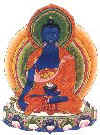|
|
||||
|
Tibetan
Medicine - Tibetan
medicine - How
Maha
Kumbh
Heritage
- Ritu
Kumar - Designing
Exhibition
|
|
|
||
|
the-south-asian.com January 2001 |
||||
|
Page 1 of 3
Tibetan Medicine - How
and Why it Works
Tibetan medicine is a traditional system of medicine which has been practiced for over 2500 years and is still practiced today although Tibetans are now in exile. The headquarters of the Tibetan Medical and Astrological Institute, also known as Men-Tsee-Khang (Men = medicine, Tsee = Astrology, Khang = House/Centre) are now based in Dharamsala, North India. It is here that all the Tibetan doctors now receive their training, and it is also where the medicines are manufactured. The period of training before one qualifies as a Tibetan doctor is for a minimum of seven years. For the student to understand the medical texts, a knowledge of Tibetan linguistics, grammar and poetry is required. The first four years of training are taken up with studying the four main medical tantras, or rGyud-bzhi; they are the root tantra, the exegetical tantra, the oral tradition tantra containing methods and instructions, and finally the subsequent tantra. In the fifth year students take exams both oral and written on these four tantras. For the sixth and seventh years students are sent for practical training under a senior and experienced doctor at one of the branches of the Tibetan Medical and Astrological institute. At present there are over 30 branches in India and Nepal, and in addition to this there are a number of private clinics. Tibetan medicine still survives in Tibet where the Chinese have destroyed so much of the Tibetan tradition and culture. It has survived because it is of great practical help for them. Tibetan medicine is one of the five major sciences, and it is called gSoba Rig-pa, the science of healing. It uses different kinds of ingredients such as herbs, trees, rocks, resins, soils, precious metals, saps etc. However, 95% of Tibetan medicine is based on herbs, and precious metals are used for the seven kinds of precious pills known as Rinchen rilpo. If the physician is able to make the right diagnosis and administer the right medicine, then Tibetan medicine is good for all kinds of illness. However, it has been particularly successful in its treatment of chronic diseases such as rheumatism, arthritis, ulcers, chronic digestive problems, asthma, hepatitis, eczema, liver problems, sinus problems, anxiety and problems connected with the nervous system. Brief Description of the Nyipa sum The basic theory of Tibetan medicine is to keep in balance the Nyipa sum - they are rLung (pronounced loong), mKhris-pa and Bad-kan. The long-term causative factors of Nyipa sum are the three poisons of desire, hatred and delusion which show how closely connected Tibetan medicine is with Buddhist philosophy. So this introduction will now be divided
into four parts. Firstly I will give a brief description of the Nyipa sum
- their type, location and function within the human body. Secondly I will
describe what happens when the Nyipa sum are imbalanced. Thirdly I
will talk about the diagnosis of these Nyipa sum when they are
imbalanced. Finally after diagnosis, I will talk about their treatment The general description of rLung is that it is a subtle flow of energy and out of the five elements (air, fire, water, earth and space) it is most closely connected with air. However it is not simply the air which we breathe or the wind in our stomachs, it goes much deeper than that. rLung is like a horse and the mind is the rider, if there is something wrong with the horse the rider will not be able to ride properly. Its description is that it is rough, light, cool, thin, hard, movable. The general function of rLung is to help growth, movement of the body, exhalation and inhalation and to aid the function of mind, speech and body. rLung helps to separate in our stomachs what we eat into nutrients and waste products. However its most important function is to carry the movements of mind, speech and body. The nature of rLung is both hot and cold. Five types of rLung There are five types of rLung.
Five types of mKhris-pa mKhris-pa is the hot nature within our body and not simply the bile which comes from our gall bladder. Among the five elements, mKhris-pa is related to fire. The description of mKhris-pa is oily, sharp, hot, light, pungent and moist. The most important function of mKhris-pa is to keep in balance the bodily temperature. It helps with the digestion of food and it is what makes us feel hungry and thirsty at the right times. It also gives lustre to the skin and helps to keep the pores clear. The nature of mKhris-pa is hot like fire or the sun.
Five types of Bad-kan Bad-kan is not the phlegm which comes from the chest, it is all the diseases connected with the cold nature called Bad-kan. Among the five elements it is related to both water and earth. The description of Bad-kan is oily, cool, heavy, blunt, smooth, steady and sticky. The main function of Bad-kan is to sustain the bodily liquids. It helps to mix food in the stomach, steady the mind, and it helps to keep our joints flexible. The nature of Bad-kan is cold, like water or the moon.
This is a brief description of the type, location and function of the Nyipa sum. When the Nyipa sum are balanced, then what are called the seven bodily sustainers are also balanced. ________________________ H.H. The Dalai Lama on Tibetan medicine - Tibetan medicine - How and Why it works
|
||||
| Copyright © 2000 [the-south-asian.com]. Intellectual Property. All rights reserved. | ||||
| Home |
